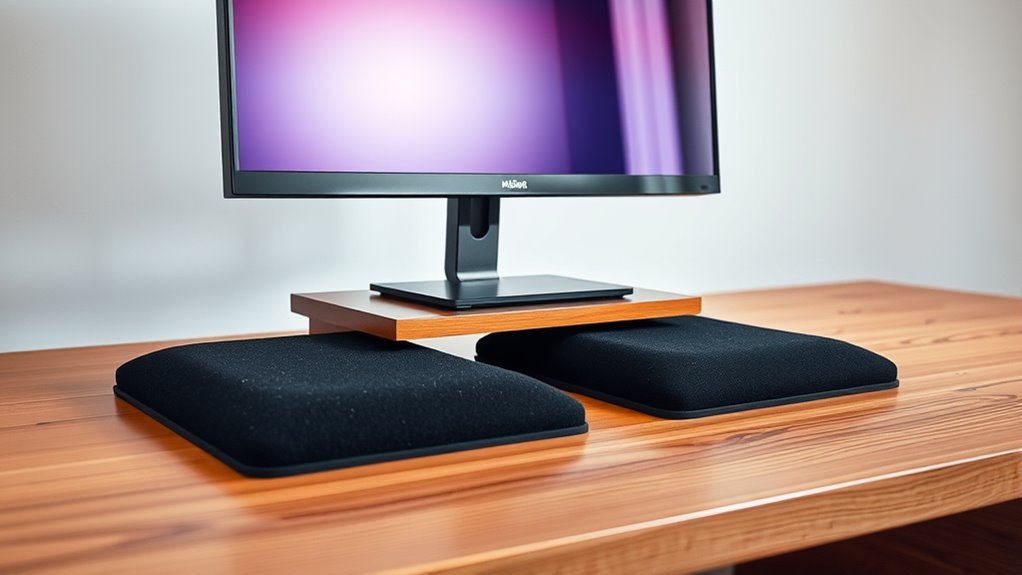Using isolation pads on monitor stands is highly beneficial for enhancing your audio experience. They reduce unwanted vibrations and resonances, ensuring clearer sound and better performance. However, be mindful that they may somewhat alter frequency response and might not eliminate all vibrations, particularly at higher volumes. It is crucial to choose the right pads based on your monitors’ weight and size to maximize effectiveness. Exploring more about these factors can further improve your setup and audio clarity.
What Are Isolation Pads and How Do They Work?
Isolation pads are specialized materials designed to decouple monitor stands from their supporting surfaces, effectively reducing unwanted vibrations and resonance. By employing a combination of elastomeric compounds and foam, these pads absorb and dissipate monitor vibration, preventing it from traveling through the surface beneath. This decoupling is essential for maintaining sound clarity, as any interference from vibrations can distort audio playback, affecting your listening experience. Additionally, isolation pads create a stable environment for monitors, ensuring that their acoustic performance remains uncompromised. When you use isolation pads, you’re not just enhancing your setup; you’re liberating yourself from the limitations imposed by unwanted resonance, allowing for a more pure and immersive sound experience. Embrace this technology to elevate your auditory freedom.
Benefits of Using Isolation Pads for Monitors
Have you ever considered how much your monitor setup impacts audio fidelity? Utilizing isolation pads can greatly enhance your audio experience by minimizing monitor vibration. These pads absorb unwanted resonances, ensuring that the sound produced is cleaner and more accurate. By reducing vibrations transmitted through your desk or stand, you’re allowing for improved sound clarity, which is vital for mixing, mastering, or simply enjoying music. This isolation permits your monitors to operate at their intended performance levels, making it easier to detect subtle details in your audio. Essentially, isolation pads create an environment where your monitors can perform at their best, granting you the freedom to focus on your sound without interference from extraneous vibrations.
Potential Drawbacks of Isolation Pads
While isolation pads can greatly enhance sound clarity, there are potential drawbacks to take into account. One concern is that while they may reduce sound transmission to surrounding surfaces, they can also inadvertently limit the natural resonance of your speakers. This restriction can alter the frequency response, leading to a less accurate representation of audio. Moreover, isolation pads may not fully eliminate unwanted speaker vibrations, which can still affect your sound experience, particularly at higher volumes. Additionally, if the pads aren’t compatible with your monitor’s weight or dimensions, they could compromise stability. Ultimately, it’s essential to weigh these factors against the benefits to determine if isolation pads align with your audio goals.
How to Choose the Right Isolation Pads
Choosing the right isolation pads requires careful consideration of several factors to guarantee peak performance. First, evaluate pad material; options like foam, rubber, or gel offer varying levels of vibration absorption and sound isolation. Foam pads tend to be lightweight and affordable, while rubber pads provide durability and stability. Next, consider size options; pads must fit your monitor stand without overspill or under-coverage. Measure your monitor’s footprint and select pads that accommodate it adequately. Additionally, assess your specific environment; heavier monitors may require thicker pads for ideal support. By focusing on these key aspects, you’ll assure that your isolation pads effectively enhance your audio experience, allowing your monitors to perform at their best while delivering the freedom you seek.
Installation Tips for Isolation Pads on Monitor Stands
To guarantee peak performance when installing isolation pads on monitor stands, it’s essential to prepare the surface thoroughly. Begin by cleaning the stand’s surface to remove dust and debris, which can hinder adhesion. Next, select the appropriate pad materials, ensuring they complement your monitor’s weight and type. During the installation process, align the pads precisely to maximize their effectiveness. If the pads have adhesive backing, peel off the protective layer and press firmly, ensuring no air bubbles are trapped. For non-adhesive options, position them securely to prevent slippage. Regularly check the integrity of the installation, replacing worn pads as necessary. This meticulous approach will enhance sound isolation and overall monitor performance, granting you the freedom to enjoy your audio experience fully.
Frequently Asked Questions
Can Isolation Pads Improve Sound Quality for Audio Monitors?
Sure, isolation pads won’t change your life, but they can enhance sound clarity and reduce vibrations. Without them, you’ll simply embrace the chaos of audio distortion, missing out on the freedom of pristine sound.
Do Isolation Pads Work on All Types of Monitor Stands?
Isolation pads can work on various monitor stand types, but effectiveness depends on the materials used. Softer materials may absorb vibrations better, while harder types might not yield significant improvements. Experiment to find the best combination.
How Long Do Isolation Pads Typically Last?
Isolation pads typically last several years, depending on longevity factors like material durability, usage intensity, and environmental conditions. Choosing high-quality materials can greatly extend their lifespan, ensuring ideal performance throughout their use.
Are Isolation Pads Safe for Heavy Monitors?
Yes, isolation pads are safe for heavy monitors, provided they’re rated for the weight. Their durability guarantees they can effectively absorb vibrations, enhancing heavy monitor safety while maintaining stability during operation. Choose wisely for best results.
Can I Use DIY Materials Instead of Commercial Isolation Pads?
Absolutely, you can use DIY materials for sound isolation. Think foam, rubber, or even carpet scraps. Just make certain they effectively absorb vibrations; otherwise, your monitors might still echo like a cavern, defeating your purpose.

